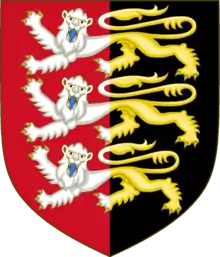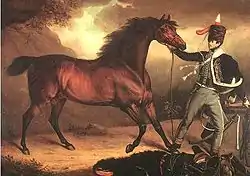Standish O'Grady, 2nd Viscount Guillamore
Colonel Standish Darby O'Grady, 2nd Viscount Guillamore (26 December 1792 – 22 July 1848) from Cahir Guillamore, County Limerick, was an Anglo-Irish politician and British Army officer.

Biography
O'Grady was born on 26 December 1792, the eldest son of Standish O'Grady, 1st Viscount Guillamore,[1] and Katherine, daughter of John Thomas Waller of Castletown. He was educated at Westminster School by 1809; and Trinity College, Dublin (1809).[2]
Military career
O'Grady was commissioned into the British army as an ensign in the 7th Hussars in 1811. Promoted to lieutenant in 1812,[2] it was in the 7th Hussars that he fought in the Waterloo Campaign. On 17 June 1815, he had command of the troop of the 7th Hussars on the high road from Genappe to Quatre Bras and was involved in the action at Genappe. The regiment was covering the British march from Quatre Bras to Waterloo. Sir William Dörnberg left O'Grady outside the town on the Quatre Bras road to hold in check the advancing French cavalry while the main body of the regiment proceeded in file across the narrow bridge of Genappe and up the steep street of the town. O'Grady advanced at the head of his troops as soon as the French appeared, and presented so bold a front that, after a time, they retired. When they were out of sight, he crossed the bridge at the entrance of Genappe. He took his troop at a gallop through the town, rejoining Sir William Dörnberg, who had drawn up the main body of the regiment on the sloping road at the Waterloo end of Genappe. A severe cavalry combat ensued when the French lancers reached the top of the town, in which O'Grady's regiment made a gallant charge, with considerable loss.[1]

The next day at the Battle of Waterloo he was stationed on the ground above Hougoumont on the British right. He wrote in a letter to his father just after the battle:[3]
The 7th had an opportunity of showing what they could do if they got fair play. We charged twelve or fourteen times, and once cut off a squadron of cuirassiers, every man of whom we killed on the spot except the two officers and one Marshal de Logis, whom I sent to the rear.
Two letters of his to Captain William Siborne, describing the movements of his regiments on 17 and 18 June 1815, are printed in Waterloo Letters, edited by Major-General H. T. Siborne (London, 1891, pp. 130–6).[1] His military career continued in fits and starts. After Waterloo he was promoted to captain, but was put into the reserves ("on half-pay") the next year, probably because his father wanted him to enter politics. However he failed to get into parliament and went back on active service as a captain in the 18th Dragoons in 1819. After his election to parliament he was again placed in the reserves in 1821. In 1825, still in the reserves, he was promoted to major. He was placed on active service with the 24th Foot from 1828 until 1829 when he was placed in the reserves. In 1842 he was promoted to Colonel and became aide-de-camp to Queen Victoria the same year—a post he held until he died.[2]
Political career
He was defeated on his first attempt in 1818 but was elected in 1820 as Member of Parliament for County Limerick, and held the seat until 1826. He was re-elected on 2 February 1830, but on 3 May his name was struck from the electoral return and replaced with that of James Dawson. O'Grady was re-elected in August 1830, and served until 1834.[2] His early period in Parliament was dominated by controversy over a parliamentary inquiry into his father's conduct as a judge. James Grattan emerged as an opponent of O'Grady in this issue and it is known they fought a duel in July 1822. O'Grady was a vigorous defender of the rights of his constituents and in 1823 on behalf of Limerick Corporation he opposed a plan by Spring Rice the MP for Limerick City to reform the borough. In 1825 he voted to suppress the Catholic Association and later the same year he refused to attend a meeting in Limerick that supported Catholic Emancipation, both these made him unpopular amongst his Catholic constituents. He was defeated in the 1826 election. Though there was a movement to have him appointed as High Sheriff of County Limerick it was ignored because after his defeat O'Grady rejoined the army in the 24th Foot which were stationed in Limerick at that time. After the death of Thomas Lloyd in 1829 O'Grady was again returned for County Limerick and this time with the support of Daniel O'Connell. His support was firmly with his Catholic constituents by this stage and he was returned unopposed later that year in the general election and despite a strong challenge by a Repeal candidate in the 1832 general election he was again returned. In the 1835 election he was replaced by William Smith O'Brien.[4]
Later life
He succeeded to the peerage as Viscount Guillamore on 21 April 1840 on the death of his father, the 1st Viscount.[2]
Family
On 16 October 1828,[6] he married Gertrude-Jane (died 1871), daughter of Berkeley Paget.[7][8] By 1832 they had had two daughters.[8] Some of their other children were:[9]
Notes
- O'Donoghue 1895, p. 52.
- Farrell 2009.
- O'Donoghue 1895, p. 52 cites "letter in possession of the Hon. Mrs. Norbury"
- "O'GRADY, Standish (1792-1848), of Mount Prospect, co. Limerick". The History of Parliament. Retrieved 2 March 2019.
- "News of the Week". West Kent Guardian. 29 July 1848. Retrieved 25 December 2015 – via British Newspaper Archive.
- Dalton 1904, p. 67.
- Mosley 1999, p. 76
- Burke 1832, p. 555.
- "Frederick Standish O'Grady, 6th Visocunt Guillamore". Geni. Retrieved 5 March 2019.
- Pine 1972, p. 139
References
- Burke, John (1832), A General and heraldic dictionary of the peerage and baronetage of the British Empire, London: H. Colburn and R. Bentley, p. 555
- Dalton, Charles (1904), The Waterloo roll call. With biographical notes and anecdotes, London: Eyre and Spottiswoode
- Farrell, Stephen (2009), "O'Grady, Standish (1792-1848), of Mount Prospect, co. Limerick.", in Fisher, D.R. (ed.), The History of Parliament: the House of Commons 1820-1832, Cambridge University Press
- Mosley, Charles, ed. (1999), Burke's Peerage and Baronetage, 1 (106th in 2 volumes ed.), Crans, Switzerland: Burke's Peerage (Genealogical Books), p. 76
- Pine, L. G. (1972), The New Extinct Peerage 1884-1971: Containing Extinct, Abeyant, Dormant and Suspended Peerages With Genealogies and Arms, London, U.K.: Heraldry Today, p. 139
Attribution:
- O'Donoghue, David James (1895), , in Lee, Sidney (ed.), Dictionary of National Biography, 42, London: Smith, Elder & Co, pp. 51–52
Further reading
- Jupp, P. J. (1986), "Co. Limerick", in Thorne, R. (ed.), The History of Parliament: the House of Commons 1790-1820, Boydell and Brewer
External links
- Leigh Rayment's Historical List of MPs – Constituencies beginning with "L" (part 3)
- Hansard 1803–2005: contributions in Parliament by Standish O'Grady
| Parliament of the United Kingdom | ||
|---|---|---|
| Preceded by Windham Quin, Lord Adare and Richard FitzGibbon |
Member of Parliament for County Limerick 1820 – 1826 With: Richard FitzGibbon |
Succeeded by Richard FitzGibbon and Thomas Lloyd |
| Preceded by Richard FitzGibbon and Thomas Lloyd |
Member of Parliament for County Limerick 1830 With: Richard FitzGibbon |
Succeeded by Richard FitzGibbon and James Dawson |
| Preceded by Richard FitzGibbon and James Dawson |
Member of Parliament for County Limerick 1830 – 1835 With: Richard FitzGibbon |
Succeeded by Richard FitzGibbon and William Smith O'Brien |
| Peerage of Ireland | ||
| Preceded by Standish O'Grady |
Viscount Guillamore 1840 – 1848 |
Succeeded by Standish O'Grady |